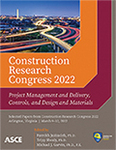Economic Vulnerability Assessment of the Construction Industry in the United States
Publication: Construction Research Congress 2022
ABSTRACT
Construction is one of the major contributors to the US economy. Due to the existing interdependencies between industries, the loss of production in one industry influences the production of other industries which are dependent on it. This makes the construction industry vulnerable to the inoperability induced by other producing sectors like manufacturing, transportation, etc. This paper presents the interdependencies between all the constituting sectors of the US economy to quantify the economic vulnerability of the construction industry. To achieve the said objective, the paper has adopted Input-output Model using Make and Use tables from the US Bureau of Economic Analysis (BEA). The outcome of this paper is the comparison of the influence of different sectors’ production inoperability on construction industry. This outcome can be used by the decision makers to identify the industries which have the potential to affect construction industry’s production thus making it resilient to the exogenous shocks in other producing sectors.
Get full access to this article
View all available purchase options and get full access to this chapter.
REFERENCES
Bhattacharyya, A. (2020): Framework for Identifying Optimal Risk Reduction Strategies to Minimize the Economic Impacts of Severe Weather Induced Power Outages. Purdue University Graduate School. Thesis. https://doi.org/10.25394/PGS.12733412.v1.
Bhattacharyya, A., Yoon, S., and Hastak, M. (2021a). Optimal Strategy Selection Framework for Minimizing the Economic Impacts of Severe Weather Induced Power Outages. International Journal of Disaster Risk Reduction, 102265. https://doi.org/10.1016/j.ijdrr.2021.102265.
Bhattacharyya, A., Yoon, S., and Hastak, M. (2021b). Economic Impact Assessment of Severe Weather–Induced Power Outages in the US. Journal of Infrastructure Systems, 27(4), 04021038. https://doi.org/10.1061/(ASCE)IS.1943-555X.0000648.
Haimes, Y. Y., and Jiang, P. (2001). Leontief-based model of risk in complex interconnected infrastructures. Journal of Infrastructure Systems. https://doi.org/10.1061/(ASCE)1076-0342(2001)7:1(1).
Haimes, Y. Y., Horowitz, B. M., Lambert, J. H., Santos, J. R., Lian, C., and Crowther, K. G. (2005), Inoperability input‐output model for interdependent infrastructure sectors. I: Theory and methodology, Journal of Infrastructure Systems, 11(2), 67–79.
Leontief, W. W. (1986). Input-output economics. Oxford University Press.
Leontief, W. W. (1951). The structure of American economy, 1919-1939: an empirical application of equilibrium analysis.
Malalgoda, C., Amaratunga, D., Keraminiyage, K., and Haigh, R. (2016). Knowledge gaps in the construction industry to increase societal resilience: a local and national government perspective. Tampere University of Technology. Department of Civil Engineering.
Naderpajouh, N., Choi, J., and Hastak, M. (2016). Exploratory framework for application of analytics in the construction industry. Journal of Management in Engineering, 32(2), 04015047. https://doi.org/10.1061/(ASCE)ME.1943-5479.0000409.
Planting, M. A. (2006). Concepts and Methods of the Input-Output Accounts. September.
Santos, J. R. (2006). Inoperability input-output modeling of disruptions to interdependent economic systems. Systems Engineering. https://doi.org/10.1002/sys.20040.
Santos, J. R., and Haimes, Y. Y. (2004). Modeling the demand reduction input-output (I-O) inoperability due to terrorism of interconnected infrastructures. Risk Analysis, 24(6), 1437–1451. https://doi.org/10.1111/j.0272-4332.2004.00540.x.
Sapeciay, Z., Wilkinson, S., and Costello, S. B. (2017), “Building organisational resilience for the construction industry: New Zealand practitioners’ perspective”, International Journal of Disaster Resilience in the Built Environment, Vol. 8 No. 1, pp. 98–108. https://doi.org/10.1108/IJDRBE-05-2016-0020.
Setola, R., De Porcellinis, S., and Sforna, M. (2009). Critical infrastructure dependency assessment using the input-output inoperability model. International Journal of Critical Infrastructure Protection, 2(4), 170–178. https://doi.org/10.1016/j.ijcip.2009.09.002.
U.S. Bureau of Economic Analysis. (2021a). Value Added by Private Industries: Construction as a Percentage of GDP [VAPGDPC], retrieved from FRED, Federal Reserve Bank of St. Louis; https://fred.stlouisfed.org/series/VAPGDPC, May 8, 2021.
U.S. Bureau of Economic Analysis. (2021b). Gross Output of Private Industries: Construction [GOC], retrieved from FRED, Federal Reserve Bank of St. Louis; https://fred.stlouisfed.org/series/GOC, May 9, 2021.
BEA (U.S. Bureau of Economic Analysis). “Make Tables/Before Redefinition” https://apps.bea.gov/iTable/iTable.cfm?reqid=58&step=102&isuri=1&table_list=4&aggregation=sum (accessed March 16, 2021).
BEA (U.S. Bureau of Economic Analysis). “Use Tables/Before Redefinition/Producer Values” https://apps.bea.gov/iTable/iTable.cfm?reqid=58&step=102&isuri=1&table_list=4&aggregation=sum (accessed March 16, 2021).
Wilkinson, S., Chang-Richards, A. Y., Sapeciay, Z., and Costello, S. B. (2016), “Improving construction sector resilience”, International Journal of Disaster Resilience in the Built Environment, Vol. 7 No. 2, pp. 173–185. https://doi.org/10.1108/IJDRBE-04-2015-0020.
Information & Authors
Information
Published In
History
Published online: Mar 7, 2022
Authors
Metrics & Citations
Metrics
Citations
Download citation
If you have the appropriate software installed, you can download article citation data to the citation manager of your choice. Simply select your manager software from the list below and click Download.
